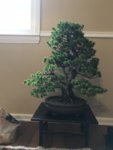I bought a new project tree a couple weeks ago, and I’m just starting to work on it:

I didn’t do anything with it until today. I was busy prepping other trees for the Nationals.
September into October is the best time to work JWP. They have fully hardened off, so their foliage won’t be damaged by the manipulations we do when we pull old needles and wire. JBP that were decandled in the summer are still growing, so it’s too early to mess with them. So, September is good for JWP, and Scots and Mugo. Those are single flush pines, and they should be finished growing for the year.
Other than the calendar, another sign JWP are ready for work is the sheaths supporting the needle clusters have dried up and mostly fallen off. And you start to see it sluffing off old needles. So, you will find some brown old needles, and yellow old needles, and some dull green old needles that are on their way to becoming yellow.
So, the first thing I did was to spend an hour or so cleaning the tree, removing the brown and yellow needles, and even some of the older green needles. I have not yet done any pruning.

You can see the mess I made. This was largely tweezer work. Old needles come off easily. If you have to really tug on them to remove them, it’s probably best to leave them on. Pulling those might injure a JWP. (JBP are different! A bit of a tug on JBP is expected!)
I start at the top when cleaning and work my way down. Needles fall off as I work, and if I had started at the bottom, the needles from the top would fall all over the bottom, and I would have had to clean it again! When I start to wire, I will start at the bottom, and work my way up. Just the opposite.
The next step is to find those places where 3 spring candles grew out, and thin those down to 2. I’ll try to find some good examples of what I’m doing and post photos in my next post.
I will update this thread as I work my way thru this tree. Stay tuned!

I didn’t do anything with it until today. I was busy prepping other trees for the Nationals.
September into October is the best time to work JWP. They have fully hardened off, so their foliage won’t be damaged by the manipulations we do when we pull old needles and wire. JBP that were decandled in the summer are still growing, so it’s too early to mess with them. So, September is good for JWP, and Scots and Mugo. Those are single flush pines, and they should be finished growing for the year.
Other than the calendar, another sign JWP are ready for work is the sheaths supporting the needle clusters have dried up and mostly fallen off. And you start to see it sluffing off old needles. So, you will find some brown old needles, and yellow old needles, and some dull green old needles that are on their way to becoming yellow.
So, the first thing I did was to spend an hour or so cleaning the tree, removing the brown and yellow needles, and even some of the older green needles. I have not yet done any pruning.

You can see the mess I made. This was largely tweezer work. Old needles come off easily. If you have to really tug on them to remove them, it’s probably best to leave them on. Pulling those might injure a JWP. (JBP are different! A bit of a tug on JBP is expected!)
I start at the top when cleaning and work my way down. Needles fall off as I work, and if I had started at the bottom, the needles from the top would fall all over the bottom, and I would have had to clean it again! When I start to wire, I will start at the bottom, and work my way up. Just the opposite.
The next step is to find those places where 3 spring candles grew out, and thin those down to 2. I’ll try to find some good examples of what I’m doing and post photos in my next post.
I will update this thread as I work my way thru this tree. Stay tuned!














